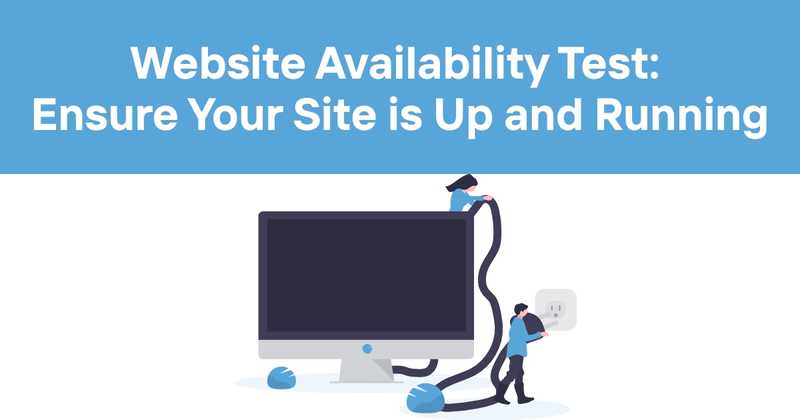Website Availability Test: Ensure Your Site is Up and Running
When it comes to running a successful website, uptime is everything. A site that's frequently down or slow to load can frustrate users, damage your reputation, and even hurt your search engine rankings. That's why performing regular website availability tests is crucial for any serious web presence.
In this article, we'll explore what website availability testing is, why it matters, and how to effectively monitor your site's uptime and performance. We'll cover key concepts, best practices, and tools you can use to keep your website running smoothly 24/7.
Table of Contents
- What is Website Availability?
- Why Website Availability Matters
- Key Metrics for Measuring Availability
- How to Test Website Availability
- Website Availability Testing Tools
- Best Practices for Maintaining High Availability
- Common Causes of Website Downtime
- Responding to Availability Issues
- The Role of CDNs in Website Availability
- Mobile Considerations for Website Availability
- Availability Testing for APIs
- Legal and Compliance Issues
- The Future of Website Availability Testing
- Conclusion
What is Website Availability?
Website availability refers to the percentage of time a website is accessible and functioning correctly for users. It's a measure of how reliably your site can be reached and used as intended.
A site with 99.9% availability, for example, would be down for about 8.76 hours per year. While that might not sound like much, even brief periods of downtime can have significant impacts, especially for high-traffic or e-commerce sites.
Availability isn't just about whether your site is up or down. It also encompasses factors like:
- Page load times
- Server response times
- Functionality of key features (e.g. shopping carts, search, forms)
- Accessibility across different devices and browsers
Why Website Availability Matters
The importance of website availability can't be overstated. Here's why it matters so much:
-
User Experience: Nothing frustrates users more than a site that's slow or unavailable. Poor availability leads to a poor user experience, which can drive visitors away.
-
Revenue: For e-commerce sites, downtime directly translates to lost sales. Even for non-transactional sites, unavailability can mean lost ad revenue or lead generation opportunities.
-
SEO Impact: Search engines like Google factor site speed and reliability into their ranking algorithms. Frequent downtime can hurt your search visibility.
-
Brand Reputation: A site that's often down or slow reflects poorly on your brand, potentially damaging customer trust and loyalty.
-
Competitive Advantage: In today's digital landscape, users expect sites to be available 24/7. Meeting (or exceeding) those expectations can give you an edge over competitors.
Key Metrics for Measuring Availability
To effectively monitor and improve website availability, it's important to track several key metrics:
-
Uptime Percentage: This is the most basic measure of availability, typically expressed as a percentage of time the site is accessible over a given period.
-
Response Time: How long it takes for your server to respond to a request. Slower response times can indicate issues even if the site is technically "up."
-
Time to First Byte (TTFB): The time between when a client makes an HTTP request and when it receives the first byte of the response.
-
Page Load Time: How long it takes for a page to fully load, including all assets like images and scripts.
-
Error Rates: The percentage of requests that result in errors (e.g. 404 Not Found, 500 Internal Server Error).
-
Availability by Geographic Region: How your site performs for users in different parts of the world.
-
Availability by Device/Browser: How consistently your site is available across different user environments.
How to Test Website Availability
Testing website availability involves regularly checking your site's accessibility and performance from multiple locations and perspectives. Here's a basic process:
-
Set Up Monitoring: Use a website monitoring service or tool to continuously check your site's status.
-
Define Check Intervals: Decide how frequently you want to test your site. Common intervals range from every minute to every 15 minutes.
-
Choose Test Locations: Select multiple geographic locations to test from, ideally covering the regions where most of your users are located.
-
Configure Alerts: Set up notifications for when your site goes down or experiences performance issues.
-
Test Key Pages and Functions: Don't just check your homepage. Test critical paths like checkout processes, search functionality, and important landing pages.
-
Analyze Results: Regularly review your availability reports to spot trends and identify areas for improvement.
-
Simulate User Actions: Use synthetic monitoring to test multi-step processes that mimic real user behavior.
-
Check SSL Certificates: Ensure your SSL certificates are valid and up-to-date to prevent security-related availability issues.
Website Availability Testing Tools
There are numerous tools available for testing website availability. Here are some popular options:
-
Pingdom: Offers comprehensive uptime monitoring and performance analysis.
-
UptimeRobot: Provides free basic monitoring with paid plans for more advanced features.
-
StatusCake: Offers a range of monitoring services including uptime, page speed, and domain monitoring.
-
New Relic: Provides detailed performance monitoring and diagnostics for web applications.
-
Google Analytics: While primarily for traffic analysis, it can also provide insights into site availability and performance.
-
WebPageTest: Allows you to run speed tests from multiple locations and browsers.
-
Odown: Offers uptime monitoring for websites and APIs, along with public status pages and SSL certificate monitoring.
When choosing a tool, consider factors like:
- The locations you can test from
- The types of checks available (HTTP, ping, full page load, etc.)
- Reporting and analytics capabilities
- Integration with other tools you use
- Pricing and scalability
Best Practices for Maintaining High Availability
Achieving and maintaining high website availability requires ongoing effort and attention. Here are some best practices to follow:
-
Use Reliable Hosting: Choose a reputable hosting provider with a strong track record for uptime.
-
Implement Redundancy: Use load balancers and multiple servers to distribute traffic and provide failover options.
-
Optimize Performance: Regularly optimize your site's code, database queries, and server configurations to improve speed and reliability.
-
Monitor Proactively: Don't wait for users to report issues. Use monitoring tools to catch problems early.
-
Have a Backup Strategy: Regularly back up your site and data, and test your restoration process.
-
Use a Content Delivery Network (CDN): CDNs can improve availability by distributing your content across multiple geographic locations.
-
Implement Caching: Proper caching can reduce server load and improve response times.
-
Plan for Traffic Spikes: Ensure your infrastructure can handle sudden increases in traffic.
-
Keep Software Updated: Regularly update your CMS, plugins, and server software to patch security vulnerabilities and improve performance.
-
Use SSL Properly: Ensure your SSL certificates are valid and properly implemented to avoid security-related downtime.
Common Causes of Website Downtime
Understanding the common causes of downtime can help you prevent and quickly address availability issues:
-
Server Overload: When your server can't handle the volume of requests it's receiving.
-
Software Bugs: Errors in your site's code or CMS can cause crashes or functionality issues.
-
Database Issues: Problems with database connections or query performance can bring a site down.
-
Network Problems: Issues with your hosting provider's network or internet routing can cause outages.
-
DDoS Attacks: Distributed Denial of Service attacks can overwhelm your servers.
-
Human Error: Mistakes during updates, configuration changes, or content management can cause downtime.
-
Hardware Failures: Physical server components can fail, causing outages if proper redundancy isn't in place.
-
Maintenance Windows: Planned downtime for updates or migrations can affect availability if not managed properly.
-
Domain or DNS Issues: Problems with domain registration or DNS configuration can make your site unreachable.
-
Third-Party Service Failures: If your site relies on external APIs or services, their downtime can affect your availability.
Responding to Availability Issues
When availability problems do occur, having a clear response plan is crucial:
-
Rapid Detection: Use monitoring tools to catch issues as soon as they happen.
-
Initial Assessment: Quickly determine the scope and potential cause of the problem.
-
Communication: Keep stakeholders (including users) informed about the issue and your efforts to resolve it.
-
Triage and Resolution: Address the most critical issues first, working through a prioritized list of tasks.
-
Root Cause Analysis: Once the immediate issue is resolved, conduct a thorough analysis to prevent similar problems in the future.
-
Documentation: Keep detailed records of the incident, your response, and lessons learned.
-
Testing: After resolving an issue, conduct thorough testing to ensure full functionality has been restored.
-
Follow-up: Implement any necessary changes or improvements identified during your analysis.
The Role of CDNs in Website Availability
Content Delivery Networks (CDNs) play a crucial role in improving website availability:
-
Reduced Server Load: By caching and serving static content, CDNs reduce the load on your origin server.
-
Geographic Distribution: CDNs serve content from locations closer to the user, improving speed and reliability.
-
DDoS Protection: Many CDNs offer built-in protection against DDoS attacks.
-
SSL Offloading: CDNs can handle SSL/TLS encryption, reducing the computational load on your servers.
-
Redundancy: If one CDN node fails, traffic can be routed to others, improving overall availability.
When implementing a CDN, consider:
- Which content to serve through the CDN
- How frequently to purge the CDN cache
- How to handle dynamic content
- The geographic locations of CDN nodes
Mobile Considerations for Website Availability
With mobile traffic often exceeding desktop, it's crucial to consider mobile-specific availability issues:
-
Responsive Design: Ensure your site functions well across various screen sizes and orientations.
-
Mobile Network Variability: Test your site's performance under varying network conditions (3G, 4G, 5G, etc.).
-
Touch Interactions: Verify that all interactive elements work properly on touch screens.
-
App Deep Linking: If you have a mobile app, ensure deep links to your website function correctly.
-
Mobile-Specific Features: Test features like click-to-call or location services on mobile devices.
-
Accelerated Mobile Pages (AMP): Consider implementing AMP for faster loading on mobile devices.
-
Mobile-First Indexing: Remember that Google primarily uses the mobile version of your site for indexing and ranking.
Availability Testing for APIs
If your website relies on APIs (either internal or external), it's crucial to include them in your availability testing:
-
Endpoint Monitoring: Regularly check that all API endpoints are accessible and responding correctly.
-
Response Time Tracking: Monitor and set thresholds for API response times.
-
Payload Testing: Verify that APIs handle various payload sizes and types correctly.
-
Error Handling: Test how your site handles API errors or timeouts.
-
Rate Limiting: Ensure your API can handle expected request volumes and correctly implements rate limiting.
-
Authentication: Regularly test API authentication mechanisms.
-
Versioning: If you support multiple API versions, test availability for all supported versions.
Legal and Compliance Issues
Website availability can have legal and compliance implications, especially for certain industries:
-
Service Level Agreements (SLAs): If you've committed to specific uptime percentages, failing to meet them could have legal consequences.
-
E-commerce Regulations: In some jurisdictions, extended downtime could be seen as a failure to provide advertised services.
-
Data Protection Laws: Availability is often a component of data protection regulations like GDPR.
-
Accessibility Laws: In some cases, poor availability could be seen as a failure to provide equal access to users with disabilities.
-
Financial Regulations: For financial services websites, availability is often subject to strict regulatory requirements.
-
Healthcare Regulations: Healthcare websites may have specific availability requirements under laws like HIPAA.
Always consult with legal experts to understand the specific requirements for your industry and jurisdiction.
The Future of Website Availability Testing
As web technologies evolve, so too do the challenges and methods of availability testing:
-
AI and Machine Learning: Expect to see more tools using AI to predict and prevent availability issues before they occur.
-
IoT Integration: As more devices connect to the internet, availability testing will need to account for a wider range of client types.
-
** 5G Impact**: The rollout of 5G networks will raise user expectations for site speed and availability.
-
Blockchain and Decentralized Web: New web architectures may require different approaches to availability testing.
-
Increased Automation: Expect more advanced, automated remediation of availability issues.
-
Edge Computing: As computing moves closer to the user, availability testing will need to adapt to more distributed architectures.
-
Quantum Computing: While still in its early stages, quantum computing could eventually revolutionize how we approach website performance and availability.
Conclusion
Website availability is a critical aspect of maintaining a successful online presence. Regular testing, proactive monitoring, and a solid understanding of the factors that influence availability are essential for keeping your site up and running smoothly.
By implementing the practices and tools discussed in this article, you can significantly improve your website's reliability and performance. Remember, high availability isn't just about avoiding downtime—it's about providing a consistently excellent user experience that builds trust and keeps visitors coming back.
For comprehensive website monitoring, including uptime checks, performance analysis, and SSL certificate monitoring, consider using a tool like Odown. With its robust feature set and user-friendly interface, Odown can help you stay on top of your website's availability and quickly address any issues that arise. By leveraging Odown's capabilities, you can ensure your site remains accessible and performant, giving your users the seamless experience they expect and deserve.



